SOWING OF 'SUPER KABUTO' И 'ONZUKA'
Valery Zlotin, Moscow, Russia
October 2001
I obtained my first seeds of Astrophytum asterias cv. 'Super Kabuto' and A. myriostigma cv. 'Onzuka' directly from Japan (thanks to the Internet and e-mail capabilities!) in July 1997. A year later I also received Astrophytum cv. 'Super Kabuto' seeds from Malta. Germination of both Japanese and Maltese seeds was about 60 %, but amongst the Japanese sprouts, only 2/3 was pure A. cv. 'Super Kabuto' and approximately 1/3 was regular green Astrophytum asterias. The Maltese seeds produced about 1/3 of cultivars. I have to admit that I had bad luck: even amongst the Japanese sprouts there were none of entirely white plants.
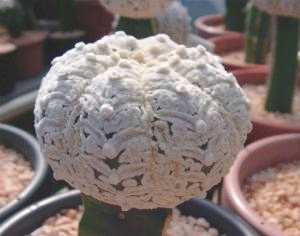 | 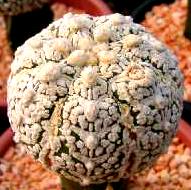
|
Photo 1.| Photo 2.
| |
From these seedlings, I keep now five A. asterias cv. 'Super Kabuto' and five A. myriostigma cv. 'Onzuka', and also three regular A. asterias, which remotely resemble A. asterias cv. 'Super Kabuto'. In 2000 (when the plants were 3 years old), one of the three A. asterias cv. 'Super Kabuto' bloomed, I pollinated it with a regular A. asterias and sowed the seeds (about 80) in October 2000, with the hope that the hybrids will may have splintered features, and at least some of the plants will have features of A. asterias cv. 'Super Kabuto'. Now the seedlings are about 8-12 mm and there is nothing interesting amongst them.
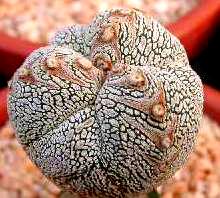 | 
|
Photo 3.| Photo 4.
| |
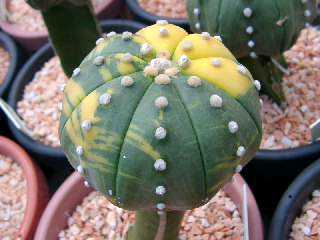 |
| Photo 5. |
Andrey Vosian, Moscow, Russia
October 2001
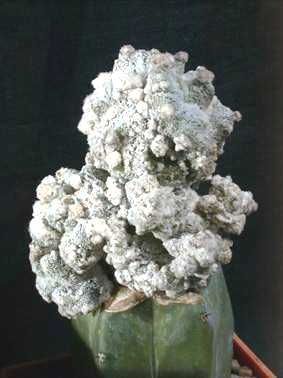 |
| Photo 6. |
Based on my experience, I think that cultivars cannot be treated by standard rules. This applies to both Astrophytum asterias cv. 'Super Kabuto' and A. myriostigma cv. 'Onzuka', as well as to little-ribbed A. myriostigma. I had an experience when seedlings of three-ribbed cultivar of A. myriostigma lost excessive fourth rib only on the second year. It has been more than a year since that time, and there are no reverse changes, the seedlings resemble more or less those adult plants that I had obtained. Besides that, I have a couple of crops of A. asterias cv. 'Super Kabuto', 100 seeds each (this is quite a big sample to make definitive conclusions). The seeds were obtained from Piltz, Germany, in different times. Many of the seedlings became decorative only during the second year of life. As time goes by, the difference becomes more and more pronounced...
ILLUSTRATIONS
Photo 1-5. Plants from Thanin Bannarakna. Those who would like to learn about (and maybe obtain) variety of Astrophytum cultivars are welcome to visit his web site at http://www.incrediblecactus.com/.
Photo 6. Astrophytum myriostigma cv. 'Lotus Land', collection of Valery Zlotin, Moscow (http://www.vzlotin.boom.ru). As the CSSA Journal claims, this plant was originally discovered and cultivated by Lotus Land Company, in Santa Barbara, CA, USA.





